What Do You Call The Different Development Phases Of Various Animals
Learning Objectives
- List the sequence of early events in animal evolution (fertilization, cleavage, gastrulation, and organogenesis)
- Explain the significance and depict the features of fertilization and cleavage in early on animal development
- Differentiate betwixt intrinsic and extrinsic factors determining jail cell specialization
- Explicate and differentiate betwixt the roles of cytoplasmic determinants and induction in determining body axes during early animal development
The data below was adapted from Khan Academy "Introduction to development." All Khan University content is bachelor for complimentary at www.khanacademy.org
The purpose and stages of evolution
Your body consist of over 30 trillion cells, only y'all began equally a single cell: a fertilized egg, or zygote. How did you become the large, organized multicellular private that you are today? Development!
As an creature embryo develops, its cells divide, abound, and migrate in specific patterns to brand a more and more elaborate body (plant cells perform differential expansion instead of migration). To office correctly, that body needs well-divers axes (such as head vs. tail). It as well needs a specific collection of many-celled organs and other structures, positioned in the right spots along the axes and connected up with 1 another in the right ways. How are all of these complex candy accomplished and coordinated? They occur via four essential stages in early animal evolution:
- Fertilization: the process of a single sperm jail cell combining with single egg cell to form a zygote.
- Cleavage: rapid, multiple rounds of mitotic cell division where the overall size of the embryo does not increase. The developing embryo is called a blastula following completion of cleavage.
- Gastrulation: the dramatic rearrangement (movement) of cells in the blastula to create the embryonic tissue layers. These tissue layers will keep to produce the tissues and organs of the adult animal.
- Organogenesis: the procedure of organ and tissue germination via cell division and differentiation.
The last two stages, gastrulation and organogenesis, together contribute to morphogenesis: the biological processes that effect in an organism's shape and torso organization.
For this readin, we will discuss the outset two steps above, fertilization and cleavage. We will carry on with gastrulation and organogenesis in the adjacent reading.
The information below was adjusted from OpenStax Biology 43.half-dozen
Development Pace 1: Fertilization
Fertilization is the process in which a unmarried haploid sperm fuses with a single haploid egg to form a zygote. The sperm and egg cells each possess specific features that make this process possible:
The egg is the largest jail cell produced in most animals species. A man egg jail cell is approximately sixteen times larger than a human being sperm cell. The eggs of different species incorporate varying amounts of yolk, nutrients to back up growth of the developing embryo. The egg is surrounded by a jelly layer, equanimous of glycoproteins (proteins that accept sugars stuck to them), that releases species-specific chemoattractants (chemical-attractors) that guide sperm to the egg. In mammals, this layer is called the zona pellucida . In placental mammals, a layer of follicular cells surrounds the zona pellucida. The zona pellucida/jelly layer is separated from the egg by a membrane called the vitalline envelope, which is outside of the cell's plasma membrane. Merely underneath the egg's plasma membrane are cortical granules, vesicles containing enzymes that will degrade the proteins that hold the vitalline envelope effectually the plasma membrane when fertilization occurs (more on this below).
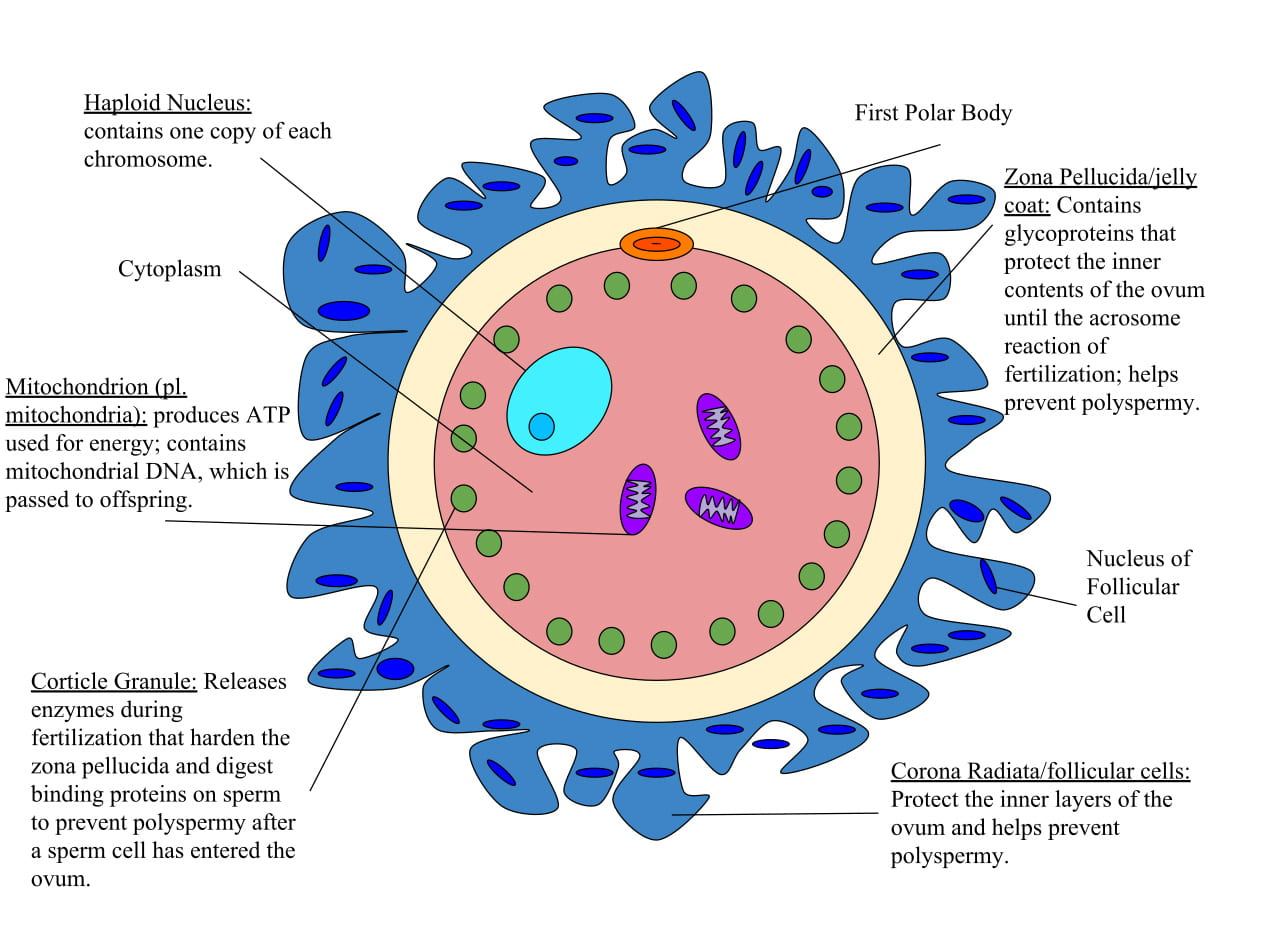
Generalized mammalian egg cell. By Mia Nicolacoudis – Own piece of work, CC BY 4.0, https://commons.wikimedia.org/westward/alphabetize.php?curid=69615546
The sperm is one of the smallest cells produced in most animal species. The sperm consists of caput containing tightly packed DNA, a flagellar tail for swimming, and many mitochondria to provide power for sperm movement. The plasma membrane of the sperm contains proteins called bindin, which are species-specific proteins that recognize and demark to receptors on the egg plasma membrane. In improver to the nucleus, the sperm head besides contains an organelle chosen the acrosome, which contains digestive enzymes that volition degrade the jelly layer/zona pellucida to permit the sperm to reach the egg plasma membrane.

By OpenStax Higher – Anatomy & Physiology, Connexions Web site. http://cnx.org/content/col11496/1.6/, Jun xix, 2013., CC BY 3.0, https://commons.wikimedia.org/w/index.php?curid=30132983
To ensure that the offspring has simply one consummate diploid gear up of chromosomes, only one sperm tin can fuse with ane egg. Fusion of more than than 1 sperm with an egg, or polyspermy, is genetically incompatible with life and results in zygote death. There are ii mechanisms that forestall polyspermy: the "fast block" to polyspermy and the "dull cake" polyspermy. These and the other steps of fertilization are described hither:
- Sperm is attracted to and contacts the jelly layer/zona pellucida.
- The interactions between receptors on the sperm cell and glycoproteins on the egg cell initiate the acrosome reaction. Digestive enzymes are released from the acrosome, and they destroy the jelly layer/zona pellucida thus creating a pathway for the sperm to arroyo the egg.
- The sperm reaches the egg plasma membrane and the sperm and egg plasma membranes fuse. This interaction is mediated past the sperm bindin proteins, which binds to bindin receptor proteins on the egg plasma membrane. This interaction is species-specific, with slightly different versions of the bindin protein and the bindin receptor proteins in every different species.
- Fusion of the sperm and egg membranes initiates electrical depolarization of the entire egg plasma membrane, temporarily (for 10-20 seconds) preventing any other sperm from fusing with the egg plasma membrane. This membrane depolarization, mediated by an influx of sodium ions, is the fast block to polyspermy.
- The membrane depolarization initiates a cross the moving ridge of calcium released across the plasma membrane.
- The calcium wave initiates the cortical reaction in the egg: the cortical granules fuse with the egg plasma membrane, releasing digestive enzymes that degrade the bindin receptor proteins that serve as sperm docking sites, and the proteins that concur the vitalline layer against the plasma membrane.
- The cortical reaction results in lifting away of the vitalline layer away from the egg plasma membrane, to create the fertilization envelope. The fertilization envelope is a barrier that prevents boosted sperm from reaching the egg, and is the slow block to polyspermy.
- These events culminate in egg activation, causing the egg to recognize that fertilization has occurred and resulting in initiation of development.
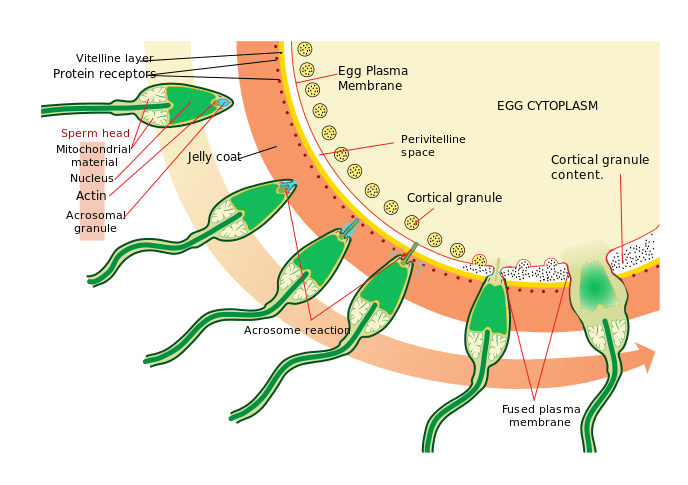
By LadyofHats. – I fabricated this diagram myself using the diagrams on: [1] , [2],and [iii]. I used Adobe Illustrator to practise it including pgf data, and I am freeing information technology into public domain. LadyofHats., Public Domain, https://commons.wikimedia.org/due west/index.php?curid=696998
The video below provides a nice overview of sexual activity cells and fertilization, including the acrosome and cortical reactions:
And this video shows what happens in sea urchin eggs immediately following fertilization, including the calcium moving ridge that initiates the cortical reaction:
Evolution Pace 2: Cleavage and Blastula Stage
After fertilization successfully activates the egg, the egg begins a series of rapid jail cell divisions called cleavage, illustrated beneath. "Typical" prison cell division occurs every 18-24 hours, but cleavage jail cell divisions can occur as frequently as every 10 minutes. During cleavage, the cells divide without an increase in size (without growing); so the large single-celled zygote divides into smaller and smaller cells called blastomeres. After the cleavage has produced over 100 blastomeres, the embryo is called a blastula. The blastula is usually a spherical layer of blastomeres that are considered to be the first embryonic tissue, the blastoderm. The blastoderm surrounds a fluid-filled or yolk-filled crenel, called the blastocoel (coelum = body cavity). The blastocoel is absolutely essential for the side by side footstep of development, gastrulation, which nosotros will talk over in the next reading.

The stages of development that nosotros've discussed and so far are very similar beyond most animal lineages. But mater stages of cleavage are a little different in mammals: the mammalian blastula is called a blastocyst, and, unlike the blastulas of other animal lineages, the blastocyst has an inner cell mass and an outer cell layer called the trophoblast. The inner cell mass will go on to form the embryo, and the trophoblast will go on to grade embryonic portion of placenta. Cleavage in a placental mammal is illustrated in the diagram below.
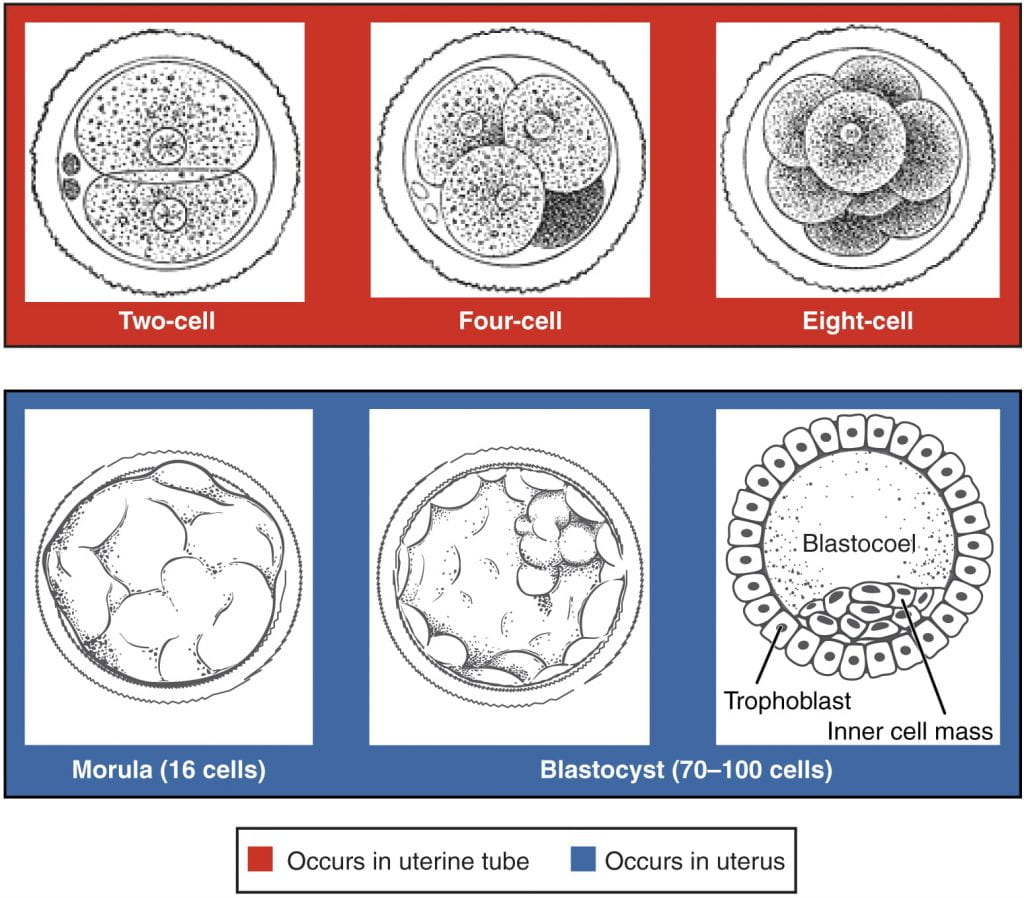
Pre-embryonic cleavages make utilise of the abundant cytoplasm of the conceptus every bit the cells speedily divide without changing the total volume.
You can visit the Virtual Man Embryo project at the Endowment for Human Development site to footstep through an interactive that shows the stages of embryo development, including micrographs and rotating three-D images.
Intrinsic vs extrinsic factors in cell specialization
The information below was adjusted from Khan Academy "Introduction to evolution." All Khan Academy content is available for free at www.khanacademy.org
We've discussed 2 of the 4 general steps in early brute evolution. Earlier nosotros move on to step number 3 (gastrulation), let's take a moment to hash out how cells "know" what they're supposed to do in an embryo, whether it's to divide, to drift to a new location, or to begin specializing into a specific cell type.
Intrinsic (lineage) information is inherited from the mother cell, every bit a result of cell partitioning. For instance, a cell might inherit molecules in its cytoplasm that "tell" it that information technology belongs to the neural, or nerve jail cell-producing, lineage of the torso. It inherits them because they were present in the cytoplasm of the mother cell, and thus they are present in the cytoplasm of the daughter cells.
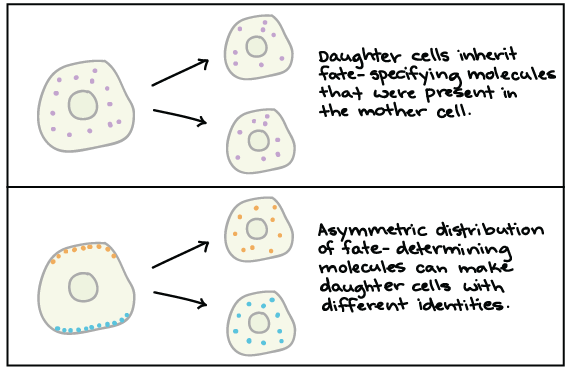
Intrinsic data is fate-specifying information establish within a prison cell. Image credit: Khan Academy https://www.khanacademy.org/science/biology/ap-biological science/developmental-biology/development-and-differentiation/a/introduction-to-development
Extrinsic (positional) information is received from the cell's surrounding surroundings or from neighboring cells. For case, a cell might get chemic signals from a neighbor, instructing it to become a item kind of photoreceptor (calorie-free-detecting neuron).

Extrinsic information is . Image credit: Khan University https://world wide web.khanacademy.org/science/biology/ap-biology/developmental-biological science/development-and-differentiation/a/introduction-to-development
Why do intrinsic and extrinsic signals thing during development? These signals are essential for the events which occur after the blastula stage of embryonic development, and (in some cases), even before that point. We'll explore how intrinsic and extrinsic data plays a function in development in the rest of this reading and the adjacent reading.
Determining the body axes: cytoplasmic determinants (intrinsic information) and induction (extrinsic data)
One of the primal principles of fauna development in all animals (except sponges) is the establishment of the body axes: animal bodies have lateral-medial (left-right), dorsal-ventral (back-abdomen), and inductive-posterior (head-feet) axes, illustrated beneath.
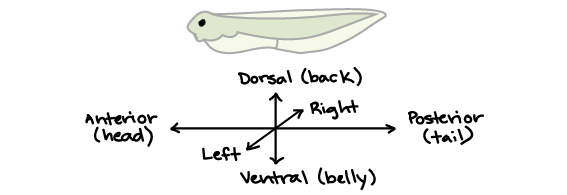
Animals have iii torso axes: anterior-posterior, dorsal-ventral, and left-right. Image credit: Khan Academy https://world wide web.khanacademy.org/scientific discipline/biology/ap-biological science/developmental-biology/development-and-differentiation/a/introduction-to-development
How are these axes established from a brawl of apparently identical cells (the blastula)? The procedure is different among different lineages of animals, with body axes beingness heavily influenced by cytoplasmic determinants in protostomes (about invertebrates), by yolk polarity in vertebrates with big amounts of asymmetrically-distributed yolk (many fish, amphibians, reptiles, and birds), and by induction (cell-cell communication) in many mammals:
- Cytoplasmic determinants are mRNAs or proteins found in the egg prior to fertilization (they come up from mom'due south genome, not the embryo). They are asymmetrically distributed, and then that later on the get-go cleavage division, the 2 different resulting cells accept different intrinsic information, which volition then lead to unlike jail cell fates. One of the best understood cytoplasmic determinants is a factor called bicoid, which is nowadays in a concentration gradient across the unfertilized eggs of Drosophila (fruit flies). The region of the egg with the highest concentration of bicoid becomes the anterior (head) portion of the embryo, while the region with the lowest bicoid concentration becomes the posterior (tail) region of the embryo. This future cell identity of anterior vs posterior is set up later the very get-go cleavage sectionalization, where one cell gets nearly all the bicoid and the other prison cell has almost none. Cytoplasmic determinants are a primal feature of protostome evolution and some deuterostomes, only they are not nowadays in mammalian embryos.
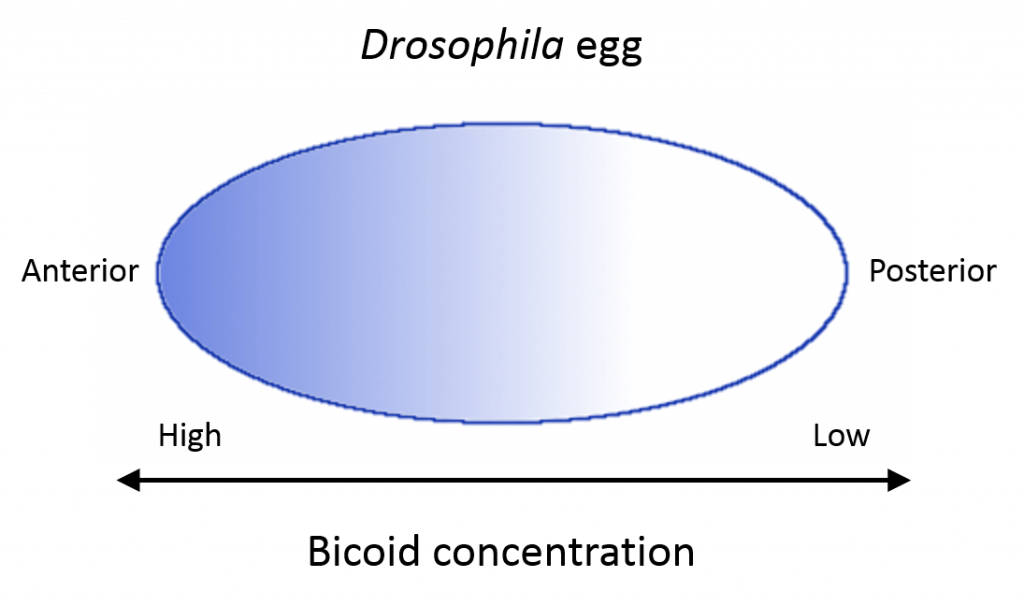
CC SA 1.0, https://eatables.wikimedia.org/w/index.php?curid=499601
- Yolk polarity is a phenomenon that occurs in the eggs of animals which have large amounts of yolk in their eggs, such every bit amphibians, reptiles, birds, and many fish. Because the egg contains so much yolk, and the yolk is literally heavier than the rest of the egg, it sinks to the bottom of the egg due to gravity. The yolk is therefore asymmetrically distributed in the egg, and the region of the egg with very lilliputian yolk will go along to get the anterior (caput) structures of the embryo, while the region of the egg containing the mass of yolk will go on to become the posterior (tail) structures of the embryo.
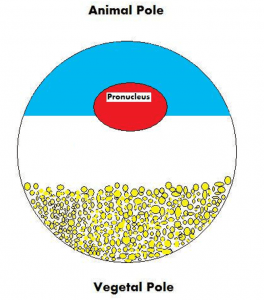
Past Catcasillas21 – Own work, CC BY 3.0, https://commons.wikimedia.org/w/index.php?curid=9576351
- Consecration, or jail cell-cell communication, is one of the five essential developmental processes, and occurs during evolution of all animal (and plant) species. Consecration is a prime example of extrinsic information that leads to different cell fates among initially identical cells. Because mammalian embryos take no cytoplasmic determinants and have very small amounts of evenly-distributed yolk, induction is the primary process responsible for establishing the body axes in mammalian embryos.
The procedure of consecration is important throughout development, and we volition revisit it in the next reading on steps 3 and 4 of early animal development.
Source: https://organismalbio.biosci.gatech.edu/growth-and-reproduction/animal-development-i/
Posted by: fieldsbespoormsed.blogspot.com

0 Response to "What Do You Call The Different Development Phases Of Various Animals"
Post a Comment